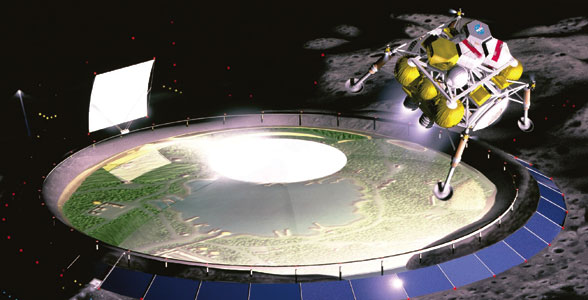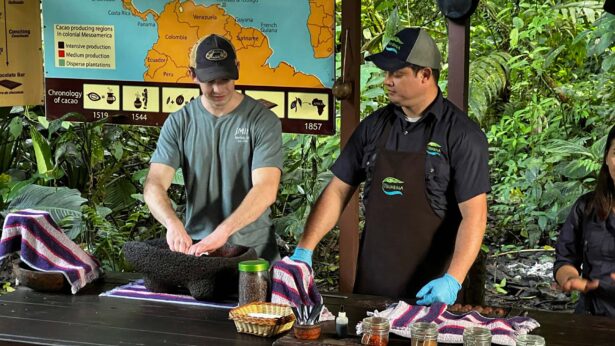By Jay Mayfield
A few times each year, light bounces just the right way through our atmosphere to give the moon an orange glow. If one UT Knoxville faculty member has his way, that lunar tint will be distinctly Big Orange.
In just a few years, the U.S. is seeking to send astronauts back to the moon, following in the footsteps of their predecessors in the Apollo program of the 1960s and 70s. This time, however, the mission reaches far beyond the already-lofty goal of simply getting to the moon and back. Humans are expected to build permanent lunar bases, learning how to use the materials available on the moon to survive and, with any luck, thrive.
UT Knoxville Distinguished Professor Larry Taylor, who heads the Planetary Geosciences Institute, says the idea is to use the moon as a proving ground to prepare for future human expeditions to Mars.
“In many ways the moon can serve as an experimental platform,” says Taylor, whose early career was spent as a NASA scientist consulting with the Apollo lunar missions. “The moon is close enough to perform rescue missions if needed, and conditions on the moon can be even worse than on Mars.”
Taylor is part of the science team on a NASA instrument called the Moon Mineralogy Mapper—“M3” for short. It’s currently orbiting the moon on the Chandrayaan-1 satellite, which was launched by India in October. Taylor points to the level of international cooperation and the presence of such new competitors in the space race as India, Japan, and China as new factors in this round of moon exploration.
As M3 orbits the moon, it is recording complex images of the moon’s surface. The data it provides allows Taylor, along with scientists at NASA and Brown University, to understand the mineralogy and composition of soil and rock on the lunar surface and determine where there may be concentrations of specific minerals for use in producing oxygen, making habitats, and other necessary materials too costly to bring from Earth. The mission has a dual purpose, according to Taylor.
“There’s a wealth of scientific knowledge here. Three billion years ago, the moon’s energy budget ran out, and the surface we see now is a type of death mask. If we can interpret the geologic aspects of that mask, there’s much we can learn.”
Past instruments have had great difficulty analyzing the mineralogy of the moon’s surface, according to Taylor, because of the copious amounts of incredibly small metallic iron particles in the soil. With M3, Taylor and his partners will be able to “see through” the camouflage that these minute iron grains create for the minerals beneath.
While the information collected by M3 is scientifically fascinating because of the picture it provides into the early life of the moon—and with it, the early days of Earth—its work also has major implications for humanity’s return to the moon.
By slowly analyzing the entire lunar surface, M3 will provide Taylor and other researchers with a roadmap to where future explorers can find the resources they need to be able to survive on the moon long term. That information will prove critical in planning missions for years to come—including possibly providing rocket fuel for humans’ first journey to Mars.
“The moon has the potential to be, essentially, a gas station in the sky,” Taylor says. “With existing rocket technology, eighty-five percent of a vehicle’s mass is fuel needed to leave Earth’s gravity. If we can find a way to create fuel using resources on the moon, it would greatly aid the process of traveling to Mars after that.”
Taylor recognizes, however, that going forward, a new generation of scientists will assume the mantle carried by him and his colleagues, who helped pioneer manned lunar exploration and the scientific efforts that have followed. That’s why in the fall semester of 2008, Taylor taught a seminar course for freshman honors students in UT Knoxville’s colleges of Arts and Sciences and Engineering.
He sees the course as part of his continuing efforts to make the moon relevant to students today, while encouraging them to follow in his footsteps.
“To these students, 1969 is a date in a history book. I want to make the kids come to the realization that ‘You’re going to be the ones going to the moon!’ ”
Angela Frantz, a UT Knoxville freshman in the College of Arts and Sciences who is planning to pursue studies in the medical field, says the course made her look at space exploration in a different light.
“I was always interested in space,” she says. “But when it comes to the moon, I hadn’t given much thought to it, other than the fact that it was there.”
Over the course of the class, Taylor covered all aspects of studying the moon, from lessons in geology and mineralogy to a historical perspective on the evolution of lunar exploration and an examination of plans to return to the moon. That includes exposing students to his collection of actual samples of lunar rock and soil returned during the Apollo missions, of which Taylor has one of the largest allocations.
Both Taylor and Frantz say one of the highlights of the course was a visit by Dr. Harrison H. “Jack” Schmitt, one of the last two astronauts to walk on the moon in December 1972 and a former U.S. senator from New Mexico.
“It’s such a different experience to learn from people like [Schmitt and Taylor], who have so much emotion behind it,” Frantz says. “When my generation reads about the space race, we don’t have anything to compare it to. We haven’t been through anything that’s been both that inspiring and scientifically important.”
That’s something that Taylor hopes to fix as he continues to teach undergraduate students alongside his ongoing and still-growing research projects, including innovative new ways to deal with the health and logistical hazards the fine lunar soil could create for future astronauts.
“I want to show people that this is not just gee whiz,” Taylor says. “There’s real value in going to the moon as mankind expands its presence into the solar system.”



